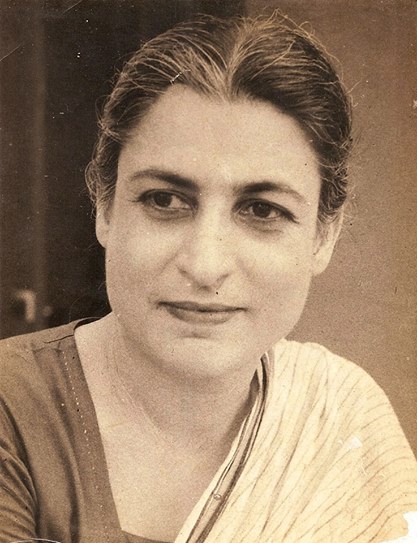Shama Zaidi does not want to talk about her mother Qudsia Zaidi nee Umt-ul-qudoos Abdullah because you do not talk about a lifetime of love and loss over a telephone wire. 2014 is the centenary year of Begum Zaidi, writer, social worker, theatre producer and founder of the Hindustani Theatre in Delhi in 1954.
The time is ripe for a tribute but Shama is understandably reticent. It has been too long and she says, “Don’t worry, no one is competing with you to write about her.” Shama, whose many achievements include a Filmfare award (shared with Kaifi Azmi) for Garam Hawa ,designing costumes for Satyajit Ray’s Shatranj Ke Khiladi and scripting many milestone Benegal films, met M S Sathyu when he was becoming a part of the energy that Begum sahiba had unleashed via Hindustani Theatre in the 1950s.
Sathyu, the legend, shares, “She was a dynamic personality, with great charm and a sense of humour. She was multifaceted, spoke very well in Urdu and English and translated many plays in Hindi and Urdu from English, Chinese and Sanskrit. She pioneered a repertory at a time when no one watched theatre.”
Because Begum Zaidi died in her 40s, her vast body of work has been relegated to history but this year her grand daughters Shaili and Seema Sathyu decided to dust family albums, piece back lost trivia and start a project to celebrate an extraordinary life. They initiated a blog (written by Poorna Swami, Seema’s daughter), a Facebook Page and there are talks of compiling Begum Zaidi’s translations and writings in an anthology.
Says Seema, “From what we hear, she was a vivacious, warmhearted, magnanimous soul. Someone who would meet even strangers like she had known them forever. Once she noticed a loner in her group of actors who would not go out with anyone because he did not have a girlfriend. She joked that she would go out with him, even though he was much younger! She had this insight into people. My nana, Bashir Husain married her very late and I am told it was a match orchestrated by common friends. My nana was very different from her. He was a member of the first Lok Sabha and Vice Chancellor of from 1956-1962. He also served as a member of the Constituent Assembly of India from United Province (later Uttar Pradesh). He was awarded Padma Vibhushan in 1976. She was the exact opposite, loved theatre with a passion but he supported her totally. It was a heady time for culture and politics and they had men like Zakir Hussain and Nehru as personal friends. She was possibly the first writer to bring Brecht to India and Indianise it. She translated The Caucasian Chalk Circle as Safed Kundali, Pygmalion became Azar Ka Khwab, Brandon Thomas’s Charley’s Aunt became Khalid Ki Khala! Many of her lost manuscripts are now being traced.”
She says incredulously, “So much was achieved by her even though the rehearsal space was just a small house with a large hall behind an exhibition ground on Mathura Road, Delhi. Today, this old rehearsal space has faded into Pragati Maidan. My mother inherited the best of both worlds, Urdu roots and an expansive worldview from nani. Even though she strayed into writing rather late.”
It would be fascinating to know where Begum Zaidi got her tireless drive from. She was born on December 23, 1914 in Delhi where her father was a senior police officer.
Seema informs, “Both her parents died when she was quite young and she moved to Lahore to live with her elder sister and brother-in-law. She was greatly influenced in college by a professor who was also an acclaimed Urdu writer and theatre enthusiast. She moved to India and after her marriage, wrote and translated a number of books for children. She also became an active part of Shankar’s Weekly Children’s Art Competitions and Book Trust. Chacha Chakkan ke Draamey is one of her most loved and performed series of plays for children.”
In the 1950s, she met Habib Tanvir and together they established the Hindustani Theatre. Says Seema, “Started as an amateur group, the Hindustani Theatre went on to become one of the first urban professional theatre companies of independent India in 1957-58. Its debut production was a Hindi-Urdu version of Kalidas’s Shakuntala, followed by Mrichakatika as Mitti Ki Gaadi.”
Zohra Sehgal was also called in to conduct a movement training workshop, M S Sathyu would routinely design the sets and Shama Zaidi would do the costumes. A blog post by great granddaughter Poorna recalls, “Mitti Ki Gaadi opened in 1958 to a full house at the All India Fine Arts and Crafts Society in Delhi. The Prime Minister of India, Jawaharlal Nehru was in the audience. But the expectant crowd received a play they hadn’t quite imagined. The actors, some in daily clothes even, paced through the audience, reciting, ‘Hum hain naye nautanki waale’ (we are the new theatre people). And so they were because from this wave emerged doyens like Sathyu, Yunus Parwaiz, Irshad Panjatan, Monica Mishra, Shyam Arora, Shiv Sharma among others.
In 1960, Begum sahiba died at the age of 45, at the peak of her powers and left a vacuum in the heart of Indian theatre, that has never been filled. She once said to an associate, ‘Today two hands are clapping, but if you continue to work at this, one day a thousand hands will clap’. But for her it was never about the applause but about creating a legacy. And that she managed to achieve in her short life.
Reema Moudgil works for The New Indian Express, Bangalore, is the author of Perfect Eight, the editor of Chicken Soup for the Soul-Indian Women, an artist, a former RJ and a mother. She dreams of a cottage of her own that opens to a garden and where she can write more books, paint, listen to music and just be.







 with
with